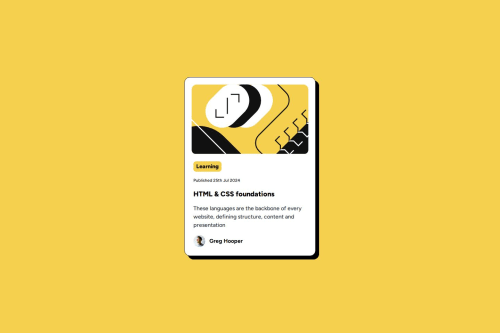Blog Card Project using React-Vite-Tailwind

Solution retrospective
On this project i am quite proud of the better understanding of the tasks. I didn't quite see the readme or style-guide on the last project, but i have safely followed the guide this time.
What challenges did you encounter, and how did you overcome them?Challenges came when i was messing around @media screen to see whether it's phone or pc size.
Thankfully i already made it responsive from the start, so it's not a huge problem.
What specific areas of your project would you like help with?I have little to no difficulty on this project. I would love some feedback instead.
Please log in to post a comment
Log in with GitHubCommunity feedback
- @haquanq
Hellooooo @RappyProg 👋👋👋
Nice work on the challenge, it look similar to the design!!
Here is some other things that can be improved:
- Each page should have one
mainlandmark which means wrap you most important content of the page inside it (there are other landmarks). - Using more semantic HTML markups and keep your HTML simple like
article, section, time,... For example you can wrap entire card insidearticleor just it's content (except image). figureis being misused here,figureis often used along withfigcaptionand wraps around contents to give it extra details/explanations (SEO and accessibility improvement ) - could think of it simply as a label/caption (not only for images, can be a list, a long paragraph,... ). Here you are usingfigurefor an image with zero context and it is redundant, leave only theimgalone is fine.- Consider add some
transitionto your hovering events:
transition-property: properties name (color, background-color, outline, border,...) transition-duration: time of ms (micro-second) transition-timing-function: ease/ease-in/... (transition behaviors) /* shorthand it looks like this*/ transition: color 200ms ease;There is a small detail that you may have missed, when you hover the title the black shadow will move!!! You can check out my solution to see (don't look at my code and try to build it yourself, it's interesting)
Hope this help 🙀🙀
- Each page should have one
Join our Discord community
Join thousands of Frontend Mentor community members taking the challenges, sharing resources, helping each other, and chatting about all things front-end!
Join our Discord